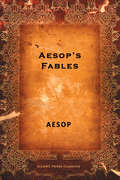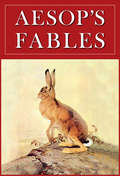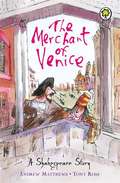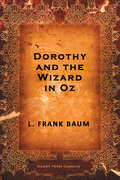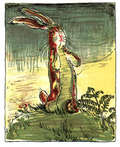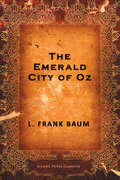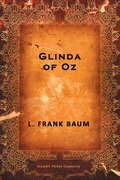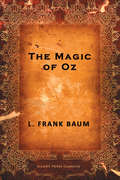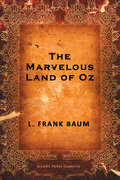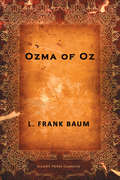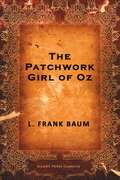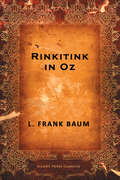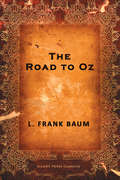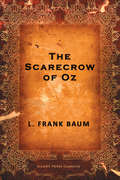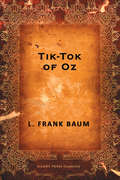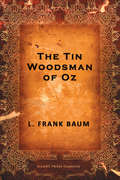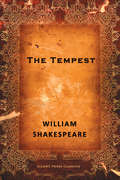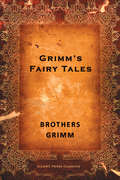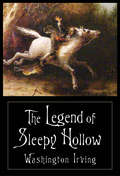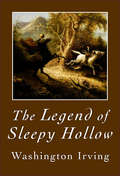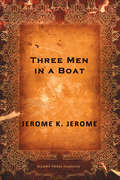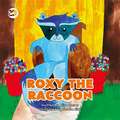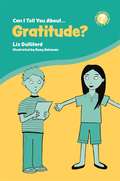- Table View
- List View
Aesop's Fables
by Aesop V. S. Vernon Jones Arthur RackhamAesop's Fables is a collection of instructive short stories, typically ending with a moral lesson. Some fables, such as "The Fox and the Crow" or "The North Wind and the Sun", have been popular for centuries.
Aesop's Fables
by AesopIt is believed that Aesop was a slave who lived in ancient Greece between 620 and 560 B.C. This illustrated collection contains 110 of his celebrated fables.
The Merchant Of Venice (PDF)
by Andrew Matthews Tony RossIn Venice, the merchant Antonio borrows money so his friend can woo a beautiful lady. He agrees that if he doesn't repay Shylock the moneylender, Shylock can take a pound of his flesh. When Antonio's ships sink and he loses his fortune, Shylock insists on the gruesome payment. . . With Notes on Shakespeare and the Globe Theatre and Love, Hate and Mercy in The Merchant of Venice. The tales have been retold using accessible language and with the help of Tony Ross's engaging black-and-white illustrations, each play is vividly brought to life allowing these culturally enriching stories to be shared with as wide an audience as possible.
Dorothy and the Wizard in Oz
by L. Frank BaumPublished in 1908, this is the story of Dorothy, her cat Eureka, her cousin Zeb, and his horse Jim and how they get swallowed up by an earthquake and end up in Oz where they meet the Wizard again.
The Velveteen Rabbit (or How Toys Become Real)
by Margery Williams William NicholsonOriginally published in 1922, The Velveteen Rabbit has delighted young readers for nearly a century. The story follows a young boy who’s given a stuffed rabbit as a Christmas gift. After the rabbit befriends other nursery toys, he comes to the realization that he wants to become a real rabbit. Eventually, the boy becomes ill and is relocated; his room is then disinfected and all the boy’s toys are thrown out, including the velveteen rabbit. The rabbit sheds a real tear causing a fairy to appear and turn him into a real rabbit. This edition includes full-color illustrations, with image descriptions,from the original illustrator, William Nicholson. Each image accompanies the text to enhance young readers’ experience and immerse them in this captivating story. Reprinted hundreds of times since its initial publication, The Velveteen Rabbit is a timeless children’s classic lets young readers experience the true magic of friendship, love, and being honest with oneself. In 2007, the book was named one of "Teachers’ Top 100 Books for Children” by the National Education Association.
The Emerald City of Oz (The Land of Oz #6)
by L. Frank BaumDorothy and the Wonderful Wizard take Aunt Em and Uncle Henry on a fabulous tour of Oz. <P><P>During their journey they encounter such amazing and amusing people as King Kleaver with his Spoon Brigade and Miss Cuttenclip of the land of paper dolls. But while Dorothy and her friends play, the wicked Nome King has joined forces with the terrible Whimsies, the fearsome Growleywogs, and the evil Phanfasms in a plot to capture the Emerald City.<P> Will Dorothy's friends discover the danger before it's too late?
Glinda of Oz (The Land of Oz #14)
by L. Frank BaumThis is the fourteenth and last Oz book. <P><P>Princess Ozma and Dorothy attempt, unsuccessfully, to stop a war between two tribes, the Skeezers and the Flatheads. The two of them are imprisoned on a glass-covered island belonging to the Skeezers, which is now located at the bottom of a lake. Only their queen, Coo-ee-oh, can raise the submerged island but after losing in battle, she becomes a swan and forfeits her magical abilities. Glinda ultimately comes to Ozma and Dorothy's rescue.
The Lost Princess of Oz (The Land of Oz #11)
by L. Frank BaumThe eleventh book in the beloved Oz series. Dorothy discovers that Princess Ozma is missing—and so are the magical treasures of Oz, including Glinda's Great Book of Records. <P><P>Most Oz residents—familiar from the previous books—join in the search, splitting into various groups. In Winkle Country, Cayke the Cookie Cook (whose magic dishpan has also gone missing) and the Frogman aid Dorothy's group in their search. As it turns out, Ugu the Shoemaker is responsible for the disappearances. A number of magical complications ensue before Ozma is found and the world of Oz is returned to order and happiness.
The Magic of Oz (The Land of Oz #13)
by L. Frank BaumThis is the thirteenth Land of Oz book, published shortly after the author's death and dedicated to "the Children of our Soldiers, the Americans and their Allies, with unmeasured Pride and Affection." <P><P> In this story, the Munchkin boy Kiki Aru finds magic instructions hidden by his father, Bini Aru. The former Nome King Ruggedo, seeking vengeance against the Emerald City, allies himself with Kiki in order to conquer Oz. They play havoc with their magic, but eventually the Wizard prevails. And Ozma's birthday is celebrated; she's given the gift of a magical flower, obtained at great effort from an unusual island.
The Marvelous Land of Oz (Classics To Go #2)
by L. Frank BaumPublished in 1904, The Marvelous Land of Oz is the story of a little boy named Tip who escapes from his evil guardian witch, with the help of Jack Pumpkinhead as well as a living Sawhorse. Tip ends up on a great adventure with a familiar Scarecrow and Tin Woodsman.
Ozma of Oz (Classics To Go #3)
by L. Frank BaumWhile traveling to a different Oz (Australia), Dorothy is lost at sea with her hen, Billina. The two end up in Ev, a country across the desert from Oz, and, with their new friend Tik-Tok, they must save the royal family from the evil Nome King.
The Patchwork Girl of Oz (Land of Oz Book #7)
by L. Frank BaumThe Patchwork Girl is one of the most delightful of the stories. The most important new character is Miss Scraps Patches, the patchwork girl herself, who is only a large stuffed doll, but very much alive thanks to the magic Powder of Life, and very brainy, because her stuffing has been well dosed with a part of the contents of all the bottles on the shelf labeled "Brain Furniture" . Then there is the Woozy, a strange little animal "all squares and flat surfaces and edges", who isn't very important except for the three hairs at the end of his tail; his only talent is his fire-flashing eyes. Another unusual creation is Bungle, a glass cat, who is completely transparent and quite conceited because of her pink brains: "You can see 'em work."
Rinkitink in Oz (The Land of Oz #10)
by L. Frank BaumOriginally published in 1916, this is the story of Prince Inga and King Rinkitink.<P><P> Most of the story takes place outside the land of Oz in the Kingdom of Rinkitink, where King Rinkitink helps Prince Inga to release his parents from imprisonment by the Nome King. It is only in the last few chapters that any of our friends from Oz enter the story, when Dorothy, after reading about Inga's adventures in Glinda's Great Book of Records, "wherein is inscribed all important events that happen in every part of the world", and watching him and his friends in Ozma's Magic Picture, decides that she and the Wizard should go and "help them out of their troubles." They do, and all ends with a splendid banquet for every one concerned in Ozma's palace.
The Road to Oz (Classics To Go #5)
by L. Frank BaumDorothy Gale of Kansas comes to the aid of 'The Shaggy Man'--a likeable hobo in ragged clothes--who asks her for directions. <P><P>It is easier to show him than explain it to him, but when Dorothy leads him to the proper road she finds a multitude of roads she did not expect and with which she is unfamiliar. She continues with Toto and The Shaggy Man and soon meets two others who are equally lost: Button-Bright, a little boy who seems remarkably stupid, and Polychrome, the daughter of the Rainbow, who is accidentally stranded on earth. Together they visit the strange towns of Foxville and Donkinton and confront a truly nasty group of beings known as Scoodlers. Eventually they arrive in Oz just in time for Ozma's birthday celebration.
The Scarecrow of Oz (The Land of Oz #9)
by L. Frank BaumOften referred to as Frank L. Baum's favourite Oz book and published in 1915, this story features Cap'n Bill and Trot's journey to Oz and, with the help of the Scarecrow, overthrow the villainous King Krewl.
Tik-Tok of Oz (The Land of Oz #8)
by L. Frank BaumThe eighth book in L. Frank Baum's beloved Oz series, Tik-Tok of Oz finds a the young Betsy Bobbin and her trusty mule, Hank, magically transported from Oklahoma to the same fantastical world once visited by Dorothy Gale. In Oz, Betsy befriends the kindly, old Shaggy Man, and agrees to help him search for his missing brother in the Nome Kingdom. Joined by the mechanical man, Tik-Tok, and a cast of colorful characters, Betsy and Shaggy Man soon find themselves dealing with a much bigger problem: trying to prevent a war between the greedy Queen of Oogaboo and the wicked King of the Nomes, which threatens all of Oz.
The Tin Woodsman of Oz (The Land of Oz #12)
by L. Frank BaumIn the twelfth Oz story, the Tin Woodman and the Scarecrow meet Woot, a Gillikin boy.<P><P> The Woodman tells him how the Wicked Witch of the East (punishing him for falling in love with her ward, Nimmie Amee) enchanted his axe, which then compelled him to chop off every part of his body. The tinsmith Ku-Klip replaced them with body parts fashioned from tin. Lacking a heart, the Woodman left her. In The Wonderful Wizard of Oz, Dorothy and the Scarecrow found him in the woods; when they reached the Emerald City, the Wizard gave him a new heart. Encouraged by Woot and accompanied by him, the Scarecrow and Polychrome, the Rainbow's daughter, the Woodman travels to the Munchkin Country to look for her. Many adventures follow, although their quest is ultimately unsuccessful, as Nimmie is now married to Ku-Klip's assistant, Chopfyt.
The Tempest
by William ShakespeareThe Duke of Milan attempts to recapture his throne by conjuring a tempest that lures his deceitful brother, Prospero, to the duke's island hideaway.
Grimm's Fairy Tales
by Jacob Grimm Wilhelm GrimmGrimm's Fairy Tales is a collection of the world's greatest tales for children, including Rumpelstiltskin, Hansel and Gretel, Rapunzel, and Little Red Cap. First published in 1812, these stories have been part of childhood—and storytelling tradition—for countless generations.
The Legend of Sleepy Hollow
by Washington IrvingThe Legend of Sleepy Hollow, along with its companion piece, Rip Van Winkle is one of the best-known short stories to have come from America—though written while Irving was living abroad in England. Best enjoyed at Hallowe'en! The story is set in 1790 in the countryside around the Dutch settlement of Tarry Town (historical Tarrytown, New York), in a secluded glen called Sleepy Hollow. Sleepy Hollow is renowned for its ghosts and the haunting atmosphere that pervades the imaginations of its inhabitants and visitors. Some residents say this town was bewitched during the early days of the Dutch settlement. Other residents say an old Native American chief, the wizard of his tribe, held his powwows here before the country was discovered by Master Hendrick Hudson. The most infamous spectre in the Hollow is the Headless Horseman, said to be the ghost of a Hessian trooper that had his head shot off by a stray cannonball during "some nameless battle" of the American Revolutionary War, and who "rides forth to the scene of battle in nightly quest of his head".
The Legend of Sleepy Hollow
by Washington IrvingThe Legend of Sleepy Hollow, along with its companion piece, Rip Van Winkle is one of the best-known short stories to have come from America—though written while Irving was living abroad in England. Best enjoyed at Hallowe'en! The story is set in 1790 in the countryside around the Dutch settlement of Tarry Town (historical Tarrytown, New York), in a secluded glen called Sleepy Hollow. Sleepy Hollow is renowned for its ghosts and the haunting atmosphere that pervades the imaginations of its inhabitants and visitors. Some residents say this town was bewitched during the early days of the Dutch settlement. Other residents say an old Native American chief, the wizard of his tribe, held his powwows here before the country was discovered by Master Hendrick Hudson. The most infamous spectre in the Hollow is the Headless Horseman, said to be the ghost of a Hessian trooper that had his head shot off by a stray cannonball during "some nameless battle" of the American Revolutionary War, and who "rides forth to the scene of battle in nightly quest of his head".
Three Men in a Boat, to say nothing of the dog
by Jerome K. JeromeAgreeing that they suffer from the serious illness of "overwork," J., George, and Harris embark on a boating holiday along the River Thames. Travelling from Kingston to Oxford, the three men prove themselves wholly unprepared for the journey, and document their misadventures with comedic brilliance.
The Wars of Napoleon
by Charles J. EsdaileA survey of the Napoleonic Wars. The central theme is the scale of French military power and its impact on other European states from Portugal to Russia and from Scandinavia to Sicily.
Roxy the Raccoon: A Story to Help Children Learn about Disability and Inclusion (Truth & Tails Children's Books)
by Alice Reeves Phoebe KirkRoxy lives in the forest with her three best friends, who she loves to visit and play games with. Roxy is in a wheelchair, so sometimes it is harder for her to go to the same places and play the same games as the other animals. Roxy and her friends realise that by making a few small changes and working together, they can make the forest a better place for everyone. Roxy teaches us that there are bunches of ways to be more inclusive of those who have a disability so that everyone can join in. Part of the Truth & Tails series, which aims to eliminate prejudices and encourage acceptance in young children aged 4-8, the story of Roxy and her friends is accompanied by hand-drawn, watercolour illustrations.
Can I Tell You About Gratitude?: A Helpful Introduction For Everyone
by Liz Gulliford Rosy SalamanMeet Maya. Maya always tries to be polite, and to remember to say 'thank you' but she wants to learn what it means to be truly grateful. Should she be grateful to her teachers for their hard work, even though they're only doing their job? Does she need to say thank you for the gifts she doesn't really like - like the pink scarf Nani gave her last birthday? And when Laura gives her some earrings but later asks to copy her history project in return, should Maya be grateful and give her the thank you letter she has written? This illustrated book is an ideal conversation starter for children aged 7+, helping them to understand what gratitude means, recognise when it is appropriate, and develop their own ability to be genuinely grateful.
